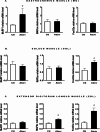Skeletal muscle fibre type-dependent effects of atorvastatin on the PI3K/Akt/mTOR signalling pathway and atrophy-related genes in rats
- PMID: 39419905
- PMCID: PMC11486814
- DOI: 10.1007/s11033-024-10005-w
Skeletal muscle fibre type-dependent effects of atorvastatin on the PI3K/Akt/mTOR signalling pathway and atrophy-related genes in rats
Abstract
Background: One of the probable causes of statin myotoxicity is an imbalance between protein synthesis and degradation. These processes are regulated by the PI3K/Akt/mTOR pathway and the ubiquitin‒proteasome system (UPS). The aim of this study was to assess whether the effects of atorvastatin on PI3K/Akt/mTOR pathway downstream proteins, the FoxO3a transcription factor and the UPS genes, i.e., MuRF-1 and MAFbx, depend on muscle fibre type.
Methods and results: Atorvastatin (50 mg/kg) was administered to Wistar rats. The levels of selected PI3K/Akt/mTOR pathway proteins were assayed via Western blotting, whereas MuRF-1, MAFbx and FoxO3a mRNA levels were measured using reverse transcription quantitative polymerase chain reaction (RT‒qPCR). Gomöri trichrome staining was performed to assess skeletal muscle pathology. A decrease in the P-Akt/Akt ratio was observed in the gastrocnemius muscle (MG), whereas an increase in the P-Akt/Akt ratio was observed in the soleus muscle (SOL). FoxO3a gene expression increased in the SOL and extensor digitorum longus (EDL) muscles. MuRF-1 gene expression increased in the MG, and MAFbx expression increased in the EDL. No histopathological changes were observed in any of the tested muscles.
Conclusions: In the absence of overt muscle damage, atorvastatin decreased the P-Akt/Akt ratio in the MG, indicating an increase in inactive Akt. Consistent with the decrease in Akt activation, rpS6 phosphorylation decreased. In SOL, atorvastatin increased the P-Akt/Akt ratio, indicating Akt activation. P-FoxO3a and the P-FoxO3a/FoxO3a ratio increased, suggesting that FoxO3a inactivation occurred. Moreover, in the SOL, atorvastatin did not affect the expression of atrophy-related genes. These findings indicate that atorvastatin has no adverse effect on the Akt pathway in the SOL. Our results showed that the effects of atorvastatin on the Akt signalling pathway and atrophy-related gene expression depend on muscle type.
Keywords: Akt pathway; Atorvastatin; Atrophy-related genes; Skeletal muscle fibres.
© 2024. The Author(s).
Conflict of interest statement
The authors declare no competing interests.
Figures











References
-
- Ward NC, Watts GF, Eckel RH (2019) Statin toxicity. Circ Res 124:328–350. 10.1161/CIRCRESAHA.118.312782 - PubMed
-
- Hoste E, Haufroid V, Deldicque L, Balligand JL, Elens L (2024) Atorvastatin-associated myotoxicity: a toxicokinetic review of pharmacogenetic associations to evaluate the feasibility of precision pharmacotherapy. Clin Biochem 124:110707. 10.1016/j.clinbiochem.2024.110707 - PubMed
-
- Bonifacio A, Sanvee GM, Bouitbir J, Krähenbühl S (2015) The AKT/mTOR signaling pathway plays a key role in statin-induced myotoxicity. Biochim Biophys Acta 1853:1841–1849. 10.1016/j.bbamcr.2015.04.010 - PubMed
MeSH terms
Substances
Grants and funding
LinkOut - more resources
Full Text Sources
Research Materials
Miscellaneous

